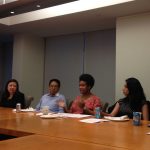//static.googleusercontent.com/external_content/picasaweb.googleusercontent.com/slideshow.swf
On June 7, AABANY took part in the 10th anniversary Caren Aronowitz Unity in Diversity celebration at the New York State Supreme Court Rotunda. This annual event is one of the highlights of the year at the courthouse, bringing together bar groups, community organizations and unions to celebrate diversity and promote greater understanding and tolerance within the courts and the wider community.
AABANY and participating organizations provided delicious food representing the diverse cultures of New York. AABANY’s table was filled with dim sum items from Nom Wah and was easily among the most popular tables at the event.
Thanks to our interns, Stephanie Yu and Max Zimmerman for staffing the table, along with interns from the chambers of Judge Doris Ling-Cohan.
From APIAVote: Census Analysis of Asian American Electorate

June 7, 2013
Add 500,000 New Voters
- The growth of the Asian American electorate was relatively steady between 2004-8 and 2008-12 (an increase of about 589,000 and 547,000 in each period). By contrast, the number of white voters rose by about 475,000 between 2004-8, and declined by about 2 million between 2008-12.
- The biggest growth in the Asian American electorate was between 2000 and 2004, with 723,000 new voters. However, 2004 was also a year that saw an increase of 10 million white voters, thereby muting the electoral affect of Asian American’s growth.
- The Asian American share of the voting population has been steadily increasing, from 1.8 percent of all voters in 2000 and 2.2 percent in 2004, to 2.6 percent in 2008, and 2.9 percent in 2012.
- Voter registration remains a significant hurdle for Asian Americans, with only 56 percent of adult citizens registered to vote in 2012. This compares to registration rates of 72 percent and 73 percent among whites and blacks, respectively, and 59 percent among Latinos.
- Once registered, however, Asian Americans turn out in rates comparable to other groups: 84 percent for Asian Americans, 82 percent for Latinos, 87 percent for whites, and 91 percent for blacks.
For more information on this growing electorate, “Behind the Numbers” is available at: http://www.apiavote.org/sites/default/files/btn_final_singles_FINAL_0.pdf.
Further details from the census report can be found at
http://www.apiavote.org/sites/default/files/Census%202012%20Voting%20Rates.pdf






